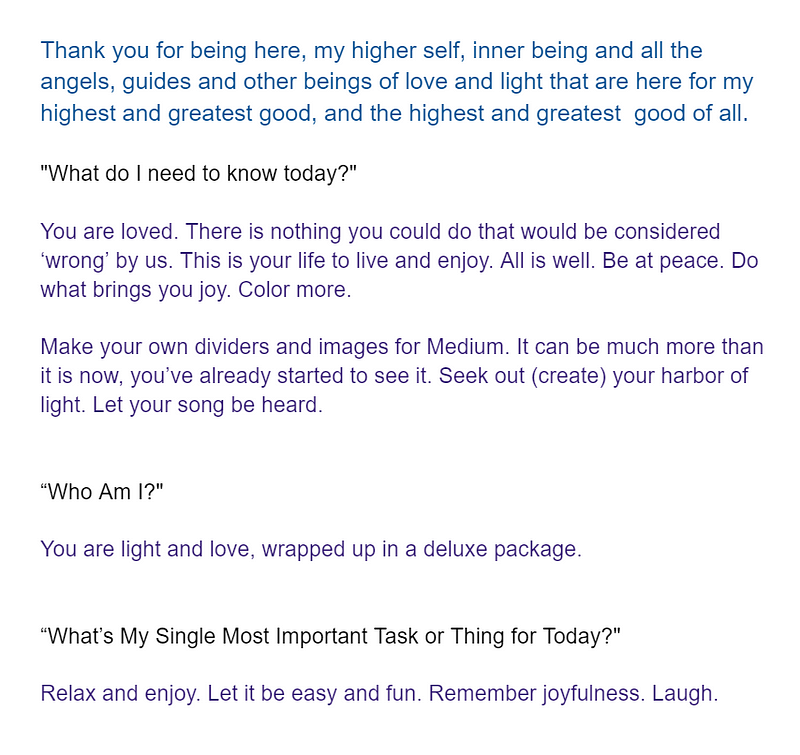Exploring the Art of Automatic Writing: A Nighttime Ritual
Written on
Chapter 1: Embracing a New Ritual
Recently, I came across an interview featuring Michael Sandler discussing his book, "AWE — the Automatic Writing Experience." This piqued my interest since I have dabbled in automatic writing previously, but I thought it would be refreshing to revisit the basics and perhaps learn some new techniques. It’s always beneficial to maintain a 'beginner’s mind.'
> "In the beginner's mind there are many possibilities, but in the expert's there are few." — Shunryu Suzuki
So, what exactly is automatic writing? It is a meditative practice where you connect with your guides, angels, higher self, or simply 'The Essence of Life' to channel your thoughts onto paper.
Michael emphasizes that this practice transcends religious boundaries—whether you identify as Christian, Buddhist, or even atheist, it remains effective.
Getting the Timing Just Right
He highlighted the significance of writing when the world around you is quiet. This minimizes the distractions from others' thoughts and feelings, making timing crucial. I initially attempted this in the morning while everyone else was asleep, but it didn't work for me. I quickly realized I am not a morning person, which only disrupted my day. Switching to late-night sessions proved to be far more effective for my rhythm.
Setting the Scene for Success
Michael recommends meditating for 5 to 10 minutes before engaging with binaural beats through headphones to enter a theta brainwave state, where receptivity is heightened. I opted for a digital journal since my handwriting can be hard to decipher. The book provides a detailed comparison between analog and digital methods, along with tips for both.
Rituals to Enhance Your Experience
The process begins with an invocation, which you should type out every time:
"Thank you, Spirit (be it God, guides, higher self, or even Albert Einstein) for being present and enveloping me in your love and light."
To guide your writing flow, he suggests three pivotal questions:
- What do I need to know?
- Who am I?
- What is one thing I should concentrate on or accomplish today?
Jot down any actionable insights on sticky notes and place them somewhere visible, as they can easily slip your mind later!
Finally, it's essential to revisit your writing after some time has elapsed. This reflection allows the material to resonate more profoundly and become relevant.
My Journey with Automatic Writing
This experience proved to be quite enlightening! I discovered it as a channel for synchronicity, and being in a receptive state felt incredibly rewarding. Engaging in this practice before sleep allowed me to connect with a higher power, which is a unique experience. I often felt sensations like gentle touches on my face or butterflies in my stomach while writing.
After practicing AWE, I enjoyed improved sleep quality and even woke up with new insights, which was an exciting development.
I utilized Google Docs for my writing, as it corrects my spelling errors and saves my work automatically, making it easier to focus on the flow without the urge to edit.

A Helpful Tip for Night Writers
For those writing late at night, I recommend trying the free software F.lux, which adjusts your screen to a warmer tone, making it less jarring for your eyes. You can download it here! It creates a calming environment conducive to winding down.
If you choose to use F.lux, consider experimenting with Darkroom Mode specifically for your automatic writing. It’s visually gentle and enhances the experience. (Pro tip: set your text color to blue beforehand so it's still visible! Trust me; I learned this the hard way.)

I thoroughly enjoyed my journey with automatic writing and highly recommend Michael Sandler's book, "AWE — The Automatic Writing Experience." He lays everything out with great clarity and care, ensuring you feel well-prepared to embark on your own journey.
Special thanks to Danielle Cousin for providing the Writing Prompts list!
Discover the captivating process of Automatic Writing in this engaging video featuring Michael Sandler.
Learn the fundamentals of Automatic Writing with Teal Swan in this insightful video, guiding you through the practice step by step.